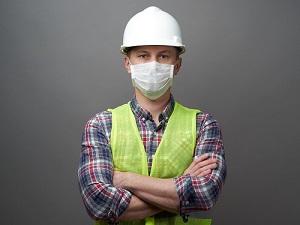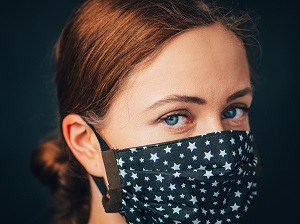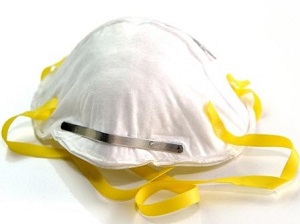Learn more about the precautions to consider when employees may be required or advised to wear face masks while at work, or who voluntarily choose to wear a face mask to prevent or slow the transmission of airborne illnesses.

Face masks and respirators can provide different levels of protection depending on the type of mask and how they are used.
Loosely woven cloth masks provide the least protection. Layered, finely woven cloth masks provide better protection. Well-fitting disposable procedure (surgical) masks and KN95s offer even more protection. Well-fitting NIOSH-approved respirators (including N95s) offer the highest level of protection.
Whatever product you choose, it should provide a good fit and be comfortable enough when worn properly, covering your nose and mouth, so that you can keep it on when you need to.
Check that your mask fits snugly over your nose, mouth, and chin. Gaps can be caused by choosing the wrong size or type of mask and when a mask is worn with facial hair.
A respirator has better filtration, and if worn properly the whole time it is in use, can provide a higher level of protection than a cloth or procedure mask.
A mask or respirator will be less effective if it fits poorly or if you wear it improperly or take it off frequently.

A cloth mask can be made from a variety of fabrics and many types of cloth face masks are available.
Wear cloth masks with:
- A proper fit over your nose, mouth, and chin to prevent leaks
- Multiple layers of tightly woven, breathable fabric
- Nose wire
- Fabric that blocks light when held up to bright light source
Do NOT wear cloth masks with:
- Gaps around the sides of the face or nose
- Exhalation valves, vents, or other openings
- Single-layer fabric or those made of thin fabric that don’t block light
- Wet or dirty material
Cloth masks should allow for breathing without restriction. Depending on frequency of use, cloth masks should be laundered so they stay clean.

A procedure mask, often referred to as a surgical mask, is a loose-fitting, disposable device that creates a physical barrier between the mouth and nose of the wearer and potential contaminants in the immediate environment. They may come with or without a face shield.
If worn properly, a procedure mask is meant to help block large-particle droplets, splashes, sprays, or splatter that may contain germs (viruses and bacteria), keeping it from reaching your mouth and nose.
Procedure masks may help reduce exposure of your saliva and respiratory secretions to others.
Procedure masks do not provide complete protection from germs and other contaminants because of the loose fit between the surface of the face mask and your face.

An N95 respirator is a respiratory protective device designed to achieve a very close facial fit and very efficient filtration of airborne particles. The 'N95' designation means that when subjected to careful testing, the respirator blocks at least 95 percent of very small (0.3 micron) test particles. If properly fitted, the filtration capabilities of N95 respirators exceed those of cloth and procedure face masks.
A proper seal between the user’s face and the respirator forces inhaled air to be pulled through the respirator’s filter material and not through gaps between the face and respirator. Even a properly fitted N95 respirator does not completely eliminate the risk of illness.
Do not wear an N95 respirator if it is wet, dirty, or if you feel like it is too difficult to breath while wearing one.

Take care when removing any face mask. Do not remove a mask by its mouth area. Instead, grab it by the straps. It is always best to immediately wash your hands after touching, handling or removing your mask. Be careful not to touch your eyes, nose, and mouth when removing a face mask.
Do not share face masks. Ensure that any face mask you wear does not interfere with your ability to complete work assignments safely. To offer protection, cloth face masks, procedure masks, and respirators need to be worn correctly and consistently.

.jpeg)

